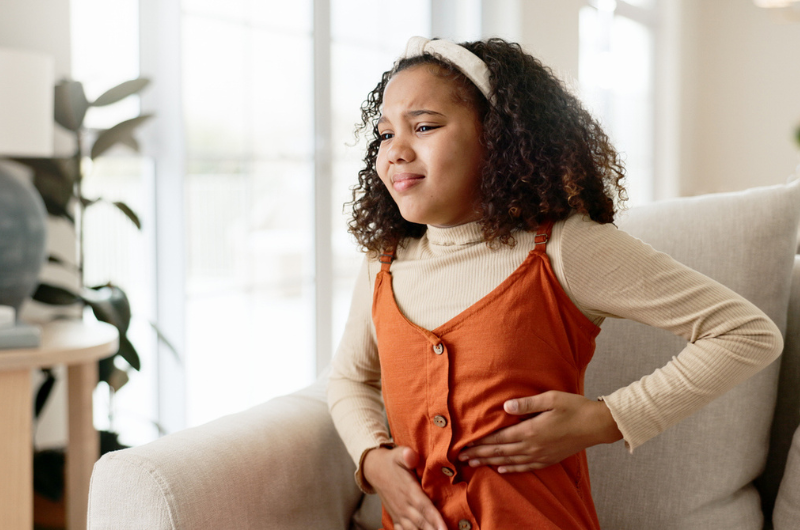A Parent’s Guide to Common Types of Stomach Pain in Kids

February 27, 2025
If you’re a parent, you’re likely familiar with tummy troubles in your little one. Eliana Shaul, M.D., a pediatric gastroenterologist at Hackensack University Medical Center, provides insights on four common types of stomach pain she sees in her practice and at-home ways to find relief.
Common Types of Stomach Pain in Kids
A range of conditions can cause stomach pain in kids and babies, from occasional indigestion to emergencies like a burst appendix. Some of the most common digestive issues in children, according to Dr. Shaul, are:
- Constipation
- Abdominal pain
- Gastroesophageal reflux disease (GERD)
- Food intolerance
Many stomachaches are temporary and resolve on their own, so it can be hard to know when discomfort is a sign of something more serious. Read on to learn how to treat common belly aches and when to seek medical care.
Constipation in Children
Depending on age, regular bowel movements can range from three times a day to once every other day, says Dr. Shaul. However, less frequent bowel movements can cause pain.
“Kids who go every four to five days almost always have pain or straining with the bowel movement,” she notes. “Additionally, if a child has a painful bowel movement, they may become afraid to have another one and hold it in. This can lead to harder and more painful stools and becomes a cycle.”
Treatment for Constipation in Children
Ask your pediatrician for advice on relieving constipation. Treatment can involve a mix of:
- Dietary changes to increase fiber or water intake
- A routine with scheduled toilet sitting at the same time each day after a meal.
- Medication, in some cases. “There are a variety of medications we use, including osmotic laxatives – the mush to make stools softer – and stimulant laxatives – the push to stimulate a bowel movement,” Dr. Shaul says.
Abdominal Pain in Kids
Stomachaches in children can have many causes. Constipation, celiac disease, infections, irritable bowel syndrome and inflammatory bowel disease can all cause abdominal pain.
Treatment for Abdominal Pain
A trip to the doctor may be needed, depending on:
- Age of the child
- Where the pain is located in the body
- How long the pain has been going on for
- The severity of the pain
For example, if a child complains of severe pain between the belly button and the lower-right side of their abdomen, this could be a sign of appendicitis, which requires immediate medical care. Usually, long-term serious causes will have red flags such as losing weight, recurrent vomiting, blood in the stool or very severe pain.
Dr. Shaul emphasizes that if you are concerned about your child, don’t hesitate to contact your pediatrician. A thorough evaluation is needed to determine the cause of the abdominal pain and the best way to treat it.
Gastroesophageal Reflux Disease (GERD) in Children
GERD is a severe, chronic form of acid reflux. It occurs when stomach contents flow back into the esophagus. This leads to pain and irritation in the abdomen, chest and throat as well as vomiting and spitting up food.
Treatments for GERD
Lifestyle changes can help manage GERD. “Eat smaller, more frequent meals instead of gigantic meals, and avoid eating right before bed,” Dr. Shaul says. In some cases, dietary restrictions or medication may be necessary.
Food Intolerances in Kids
If a child’s digestive system can’t break down a particular food, they may have a food intolerance. Lactose, a sugar found in dairy, is a common food intolerance in children. Some children are missing the enzyme lactase, which helps break down the lactose. Intolerances cause symptoms like upset stomach, bloating, nausea and diarrhea.
Food intolerances are unpleasant but not life-threatening, like allergies. An allergic reaction causes the body’s immune system to trigger responses like hives, tongue swelling and shortness of breath, which can be dangerous.
Treatment for Food Intolerances
Eliminating triggering foods or using supplements like lactase enzymes can help manage symptoms of food interlace. This approach may vary depending on the child’s tolerance level.
Dr. Shaul says consulting a health care provider for persistent symptoms is important. While many digestive issues in children are common and manageable, proper evaluation and treatment are crucial for ensuring a child’s health and comfort.
Next Steps & Resources:
- Meet our source: Eliana Shaul, M.D.
- To make an appointment with a pediatric gastroenterologist near you, call 800-822-8905 or visit our website.
- Learn more about pediatric gastroenterology at Hackensack Meridian Health.
The material provided through HealthU is intended to be used as general information only and should not replace the advice of your physician. Always consult your physician for individual care.






